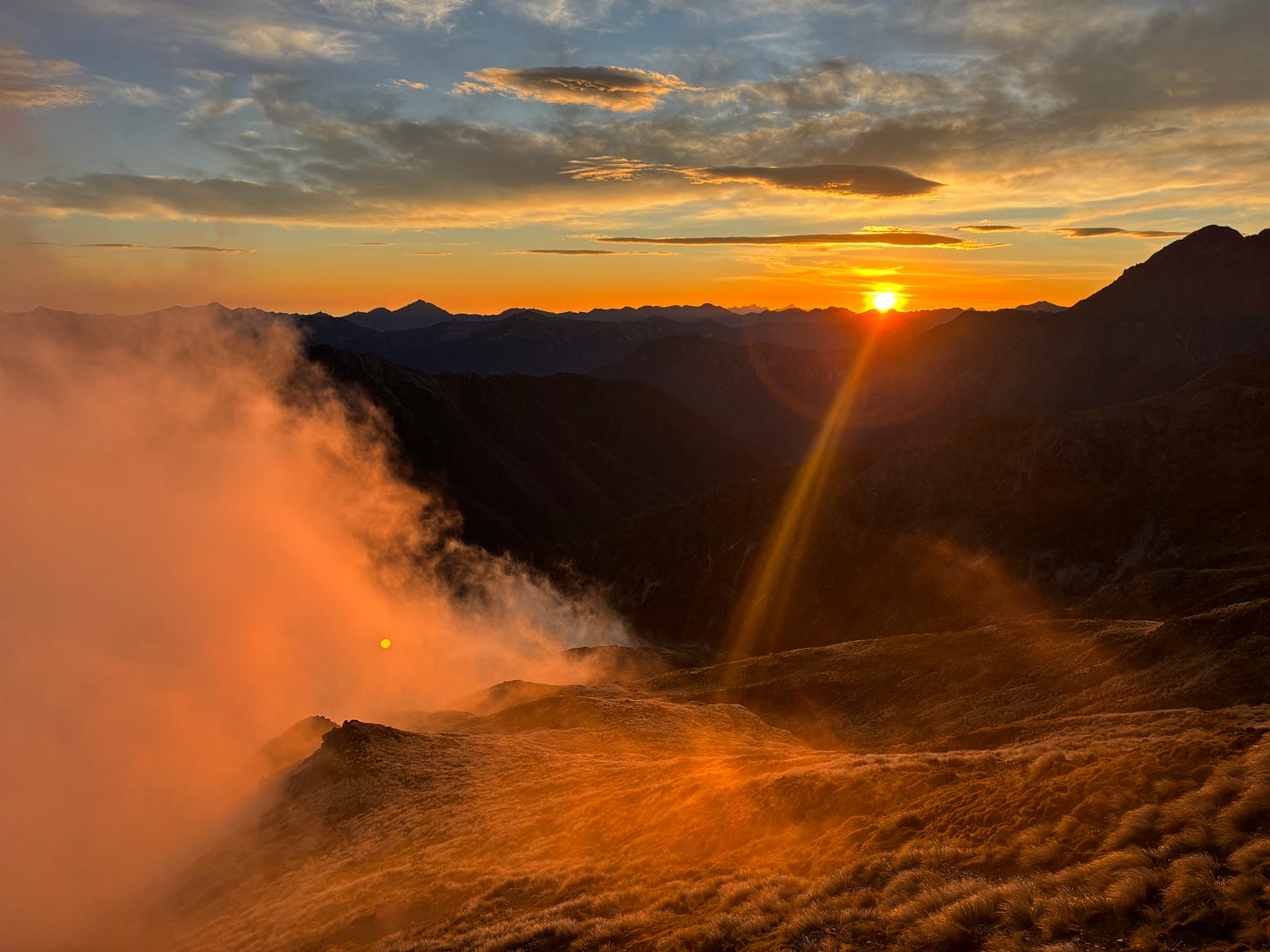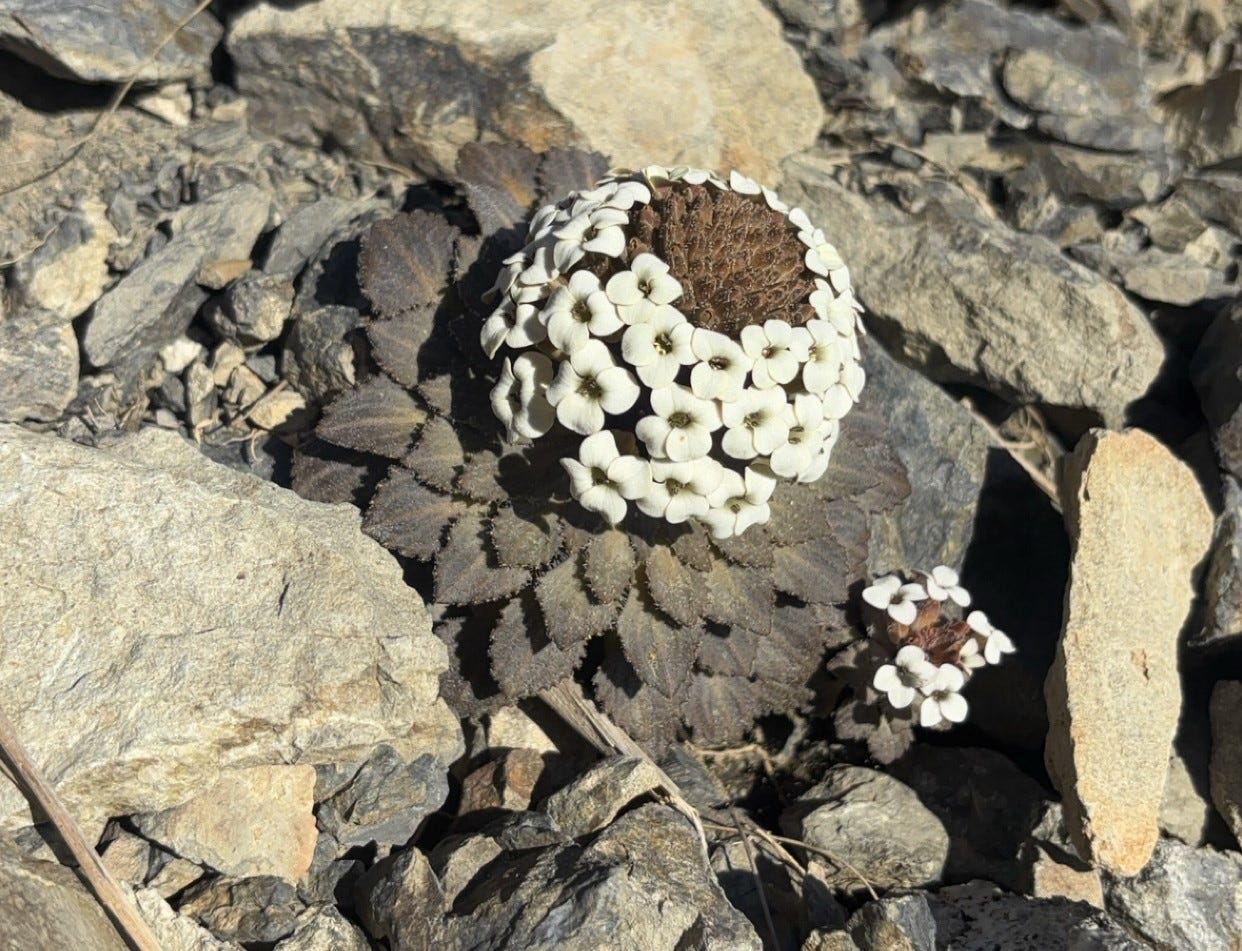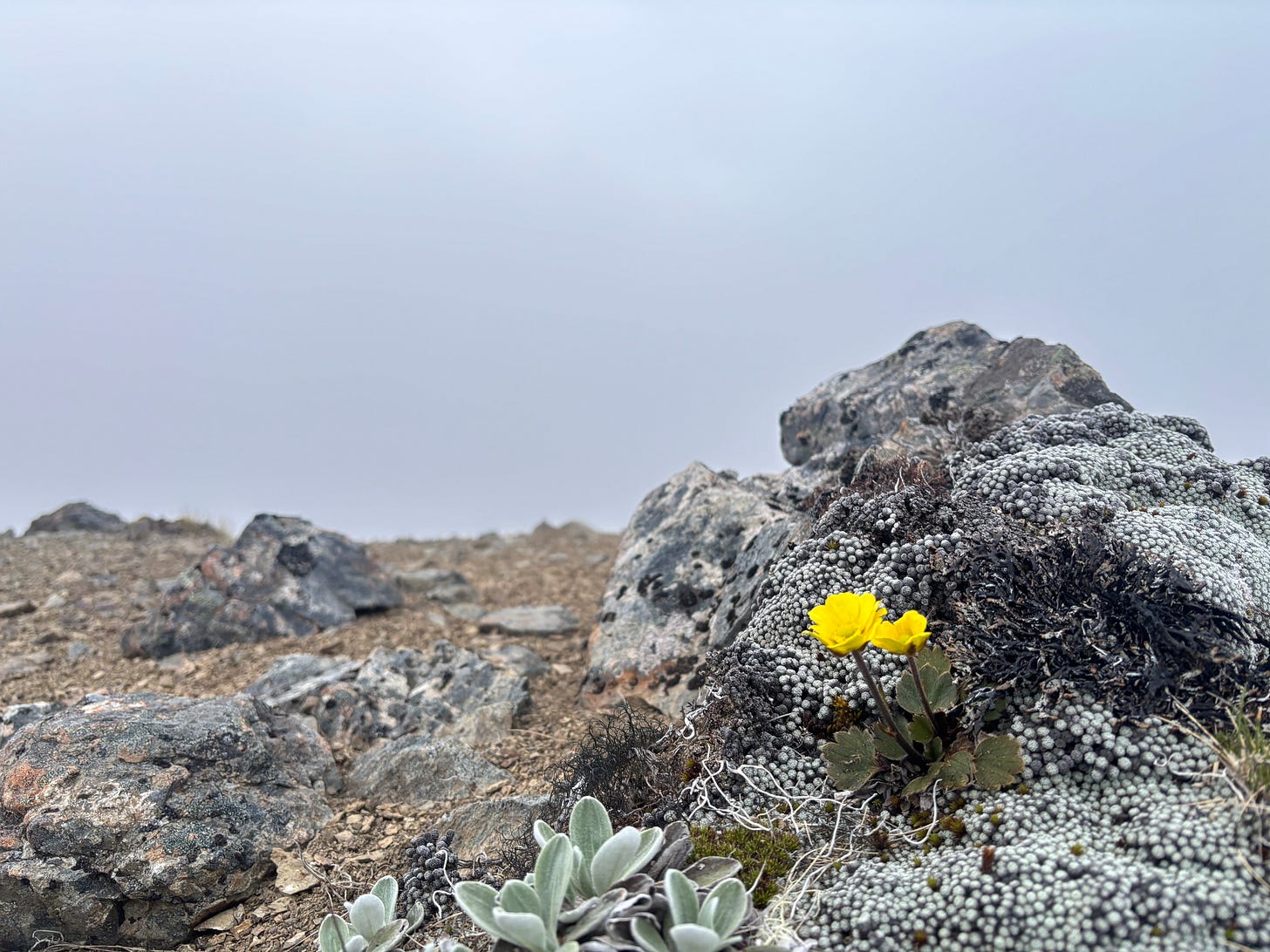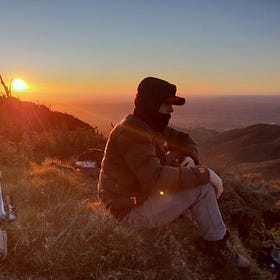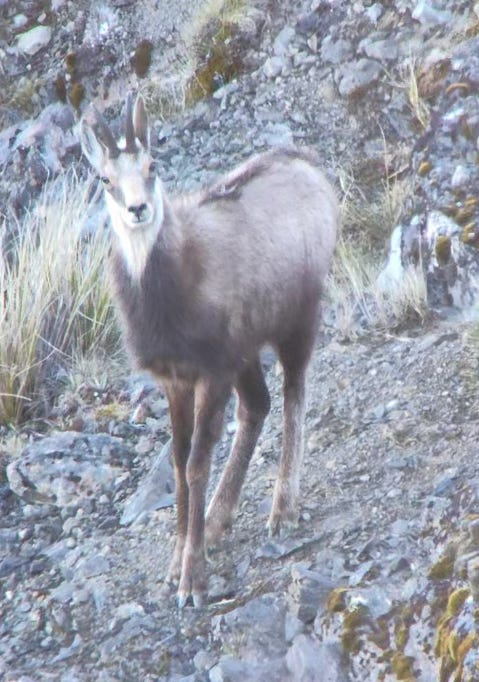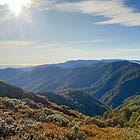Return to Paradise
Another one for the Outdoors section. I am completely burned out on social science and academia. Still keeping an eye on the exit. Here I discuss a hunting trip, Chamois, alpine frogs, etc.
If you enjoy my writing and are inclined to do so, please buy me a a coffee or like, share, or subscribe!
When we touched down on the tops of Marlborough’s Raglan Range on a sunny day in Late November, I had been back in New Zealand for less than a week. For the five months preceding I had been couped up in a tiny studio apartment in Perth’s city centre and living almost exclusively within a 5km radius of the apartment. In that entire time, my Garmin watch never registered an altitude change of more than about 20 meters.
Though I was living just off of Riverside Drive, one of the most beautiful streets in Perth, lined with giant palms and with a view across the Swan River to South Perth, I dearly missed New Zealand. I missed the bush. I missed the mountains. I missed being at altitude and looking down on folded waves of misty ridgelines, with miles of country to glass. I missed being a part of an ecosystem, hunting and butchering and eating wild game.
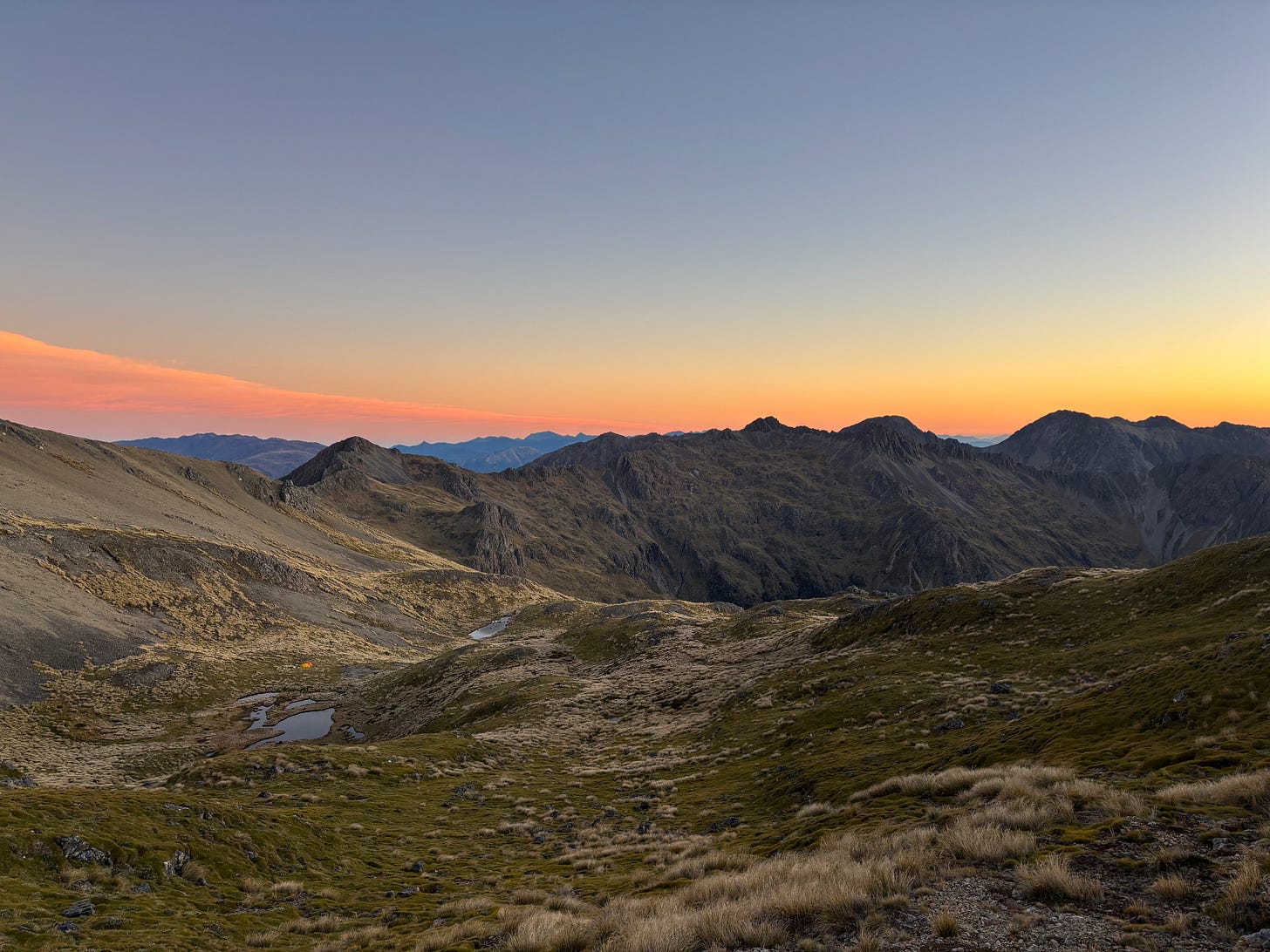
From the day I landed in Perth five months ago, this trip to Marlborough had been on the books. Me, my dad, and my two older brothers, Dan and Reon, had been looking forward to it all that time. I was a bit worried about my hill fitness. I had been running along the Swan River in Perth, and hitting the gym in preparation, but I knew that no exercise on a level plane prepares you for backcountry work on an incline. But we would be doing all our hunting (for an animal called a Chamois, more on them below) around the 1500—1800m mark, so altitude wouldn’t likely have much of an effect. I just had to be prepared to put in some good hard work. Anyway, Dad was 65, and although he can go all day he doesn’t move at pace, so if worst came to worst, me and him could do our hunting at a more leisurely speed.
For Dan, it was a return trip to the area after he and our cousin, Aaron, walked in the year before. They had put in a massive effort, braving a river crossing in the dark and then hiking to a Biv near the tops—arriving at around 2am. Upon waking the next morning Dan, still wrapped in his sleeping bag, went to sit on the Biv’s porch and do some glassing. He quickly spotted a good Chamy buck up the valley, which was accosting a younger buck. It had the young buck cornered, pressed into some rocks, and was ramming his horns down on it in what appeared to be a pretty vicious attack. He quickly got his rifle and shot the older Buck, right from the porch. He was a healthy 9 Inches. Not a bad start to the trip!
After a few difficult stalks on some other tricky bucks, Aaron soon joined Dan on the board, shooting a nice 9 ½ inch Buck himself. Animal numbers in the area did seem to be quite low, but there appeared to be a few good bucks around, which is why we returned this year.
Funnily enough, while Dan and Aaron were there the year before, shooting their two bucks, Me and Dad were not far to the West, on the Brunner Range. We were having a terrible time of it with poor weather and clag. We got one good hunt on the first afternoon, seeing a few chamois (one of which had only one horn), a couple of pigs which were absolutely tearing the place up with their rooting (and one of which I shot), and plenty of goats and deer. And then it clagged in for pretty much the entire week.
We had had multiple false alarms throughout the week, with the clag teasing us and appearing to be about to break. Dad and I would gear-up and race up to the peaks only to have it close in and start pouring for the day. So we spent most of the week just hanging out with the friendly local Weka, and the Tomtit pair who were caring for their nestlings in the woodshed. I would sit motionless in the woodshed, watching the tomtit parents fly in with their mouths stuffed with insects to feed their nestlings. Immediately after being fed, the nestlings would flip rear-end up, and excrete a tidy little fecal sac, which is exactly what it sounds like. Tomtit nestlings, along with many of the other Passerines, defecate in these sacs which encapsulate their waste within a mucous membrane, and which the parents scoop up and fly away to, I guess, deposit in some tiny landfill somewhere. This helps keep the nest clean and hygienic for the birds, as well as preventing a build-up of wastes that produce strong chemical cues which predators and parasites can pick up on.
After an incredibly frustrating week, on the last day the clag finally broke, but Dad was feeling cynical and assumed it would only clag in again, as it had every other time. So I went out on my own to try to salvage the trip and get my first ever Chamy at the last minute. The chopper pilot had said he couldn’t come and get us until 6pm, which would give me heaps of time for a hunt if the weather played along.
I quickly spotted a Chamy across the valley, sitting on the edge of a scree slip. I had to go after him. The problem was, I would have to stalk in on him mostly right out in the open, and Chamy have famously good eyesight. He appeared to spot me instantly, from about 400 meters away. I could see him staring across the valley at me, and he started to move off. I ducked back over the ridge and circled around closer, before sneaking back over the ridge again, from behind some rocky ledges. I couldn’t see him anymore, but I guess he spotted me because he started whistling at me, which in turn helped me spot him camouflaged among some rocks and scree. I was slightly disappointed to see that it was the unicorn Buck we had spotted on the first day, so I didn’t spend too much time appraising his size, though I could tell he looked decent. I shot him from about 200 meters.
Just as I got over to him, the pilot text me and said the plan’s changed, and he was on his way. I panicked; it’s not a long flight time! I didn’t even measure or photograph the unicorn Buck, I just processed him in a mad rush. I had to smash out a hefty climb, and then run all the way around the ridge tops back to our pickup point. I literally arrived at the same time as the chopper, completely exhausted. Luckily Dad had packed the last of my stuff and had it all ready to go. When we got back to civilization we measured the Buck’s single horn, it was 9 ¾ inches with a great hook! If only the horn rot hadn’t taken his other one!

Anyway, this year the four of us got dropped at one of the most beautiful camping spots ever, and were treated daily to an amazing view over the Raglan Range, with the Inland Kaikoura Mountains rising in the distance on one side, and the snowy Spenser Mountains on the other.
We pitched our tents beside a cute little tarn and spent our evenings listening to the Brown tree frogs singing in the tussock. Dan managed to catch one, and we all marveled at the tiny frogs’ ability to survive in such a harsh alpine environment. The Brown tree frog—which is an introduced frog from Australia—is ‘freeze tolerant’ but not ‘freeze avoidant’, which means it essentially freezes solid on cold days during the winter. A study on the cold tolerance and overwintering habits of the frog, found that it can survive being at -1 degree in the right microhabitat for over 12 hours and can tolerate the freezing of around 50% of its body water content (maybe more if frozen slowly). I, on the other hand, having recently returned from the 30-degree Perth weather, was struggling with the cool late-spring evenings!
However, the days were long and uncharacteristically hot, and this seemed to have pushed the Chamois into ever smaller pockets of shade, or down below the bush line. We ended up having to range further and further to find them, and we spent 15 hours a day on the hoof. We saw some reasonable animals but, being relatively new Chamy hunters, we were struggling to properly gauge their size through the spotter, and perhaps we left a few animals that were actually good enough to take.1
But I was just happy to be out there. The trip was exactly what I needed after months in the city. Everything captured my attention; the lemon-coloured alpine buttercup and the rockets of the Spaniard Speargrass looked incredible sprinkled across the hillsides. The tiny bulbous Pen wiper plants, growing out of sheer scree, were beginning to flower and gave off an incredibly sweet scent, surprisingly strong from such small plants. Every step stirred up showers of multicolored alpine crickets, and they sprang all around us with tiny ticking sounds. The coral-like Vegetable Sheep stood out on the rocky razorbacks like colonies of some strange alien fungus (though it’s a shrub not a fungus. Apparently it was named for its sheep-like appearance from a distance; sheep farmers and their dogs would be confused by them while mustering, apparently thinking they were particularly brave or stubborn sheep trying to hide in the grass).
The phenomenology of hunting: A cure for alienation and disembodiment
In my first piece on hunting I tried to articulate some of my thinking on the morality of hunting:
The Chamois: An introduction
If you aren’t familiar with the Chamois, I’ll give you a quick rundown. The chamois are a species of goat-antelope from Europe. They can be found in basically all the mountain ranges there: the Pyrenees, the Alps, the Carpathians, the Caucasus, etc. They are a small animal. The males are called bucks, the females, does, and the young are kids.
In 1907 the Austrian Emperor, Franz Joseph (after whom one of our most famous glaciers is named) traded two bucks and six does for samples of various New Zealand plants, birds, and lizards. These Chamois were released around Mount Cook, and quickly spread in range to now call home almost the entire South Island alpine environment. Being an introduced species with no natural predators in New Zealand, their numbers can explode to unhealthy numbers, thus there are no seasons or bag-limits for hunting chamois.
While the quality of their meat is debated, I find it to be of fine quality—a cross between a deer and a goat.2 But they are highly prized for their trophies, being one of the most unique game animals in new Zealand. Their value as a trophy comes in part from their aesthetic and exotic-ness, but also from their difficulty in hunting. They can occupy famously precarious and dangerous sections of the alpine environment, often preferring environments bordered by slippery scree slopes, bluffy, rocky ledges, and cliffs. They also have famously good eyesight, as well as the typical advanced sense of smell of the other game animals.
The best hunting strategy for chamois typically involves circling behind and climbing down from above them, descending to within shooting range, as the the Chamois always set up in positions with good downhill views, having occupied the higher positions in their natural habitat and thus typically being approached by predators from below. This usually involves steep climbs, hard shooting angles, and often difficult and dangerous animal recoveries. Many a chamy hunter has found himself stuck on some bluff or rocky ledge with a nervous sense that they may have ended up in a spot they can’t get back out of. Meanwhile chamois can be seen sidling and climbing cliffs in a manner which seems to defy all the laws of physics (almost like the famous ibex’s climbing skills).
On the second to last day, Dan, Reon, and I left Dad alone at camp for the evening to nurse his feet and recover. We skirted around the head of a huge valley and descended to a lookout from which we had seen a few Chamy over the past few days. I quickly spotted one which looked okay, and Dan and Reon agreed. Reon was next up, so he and Dan stalked to within a few hundred yards, and Reon put the Buck down with a perfect shot from his 7mm Rem Mag.
Suddenly there were other Chamy springing up out of the bush around Reon’s downed buck, so me and Dan stalked in closer to see if we could find them, but they vanished seemingly into thin air. We sidled over to Reon’s buck and measured him: he was a hair below 9 inches, but a really nice buck. We radioed Reon and told him that we must have somehow made a balls-up, and that he’d shot an average doe. He was incredulous, and upon arrival he was relieved to confirm our trickery. It was only his second Chamy, his first being a much smaller animal, so he was stoked with his Buck.
The rest of the trip passed with no animals shot, but plenty left to grow for next time! On the final evening we were visited by a lone Kea who spotted us from overhead and swooped in to check us out. It was my first encounter with Kea and was an experience I had desperately hoped I would be treated to on this trip, which just kept on delivering!

Upon exiting the hills we drove to Blenheim and spent a quiet evening at the great Dodson Street Beer Garden, nursing our tired bodies and enjoying a cold beer and a burger. As I’m forced to spend more and more time outside of NZ I become ever more aware of how lucky we are to live here, and to have an absolute outdoorsman’s paradise right on our doorstep. I had only been back for a week, and what a welcome home I was treated to!
If you enjoy my writing and are inclined to do so, please buy me a a coffee!
While we are primarily meat hunters, on large trips like this getting a meat and a trophy makes the most sense, and in areas with low animal numbers shooting the older bucks is better game management.
Just last night I cooked my family a meal of venison and chamois loins with a mushroom sauce. The venison was an uncharacteristically tough, while the chamois was tender and delicious.







